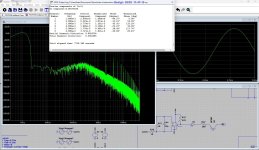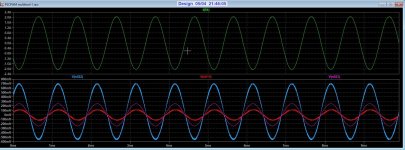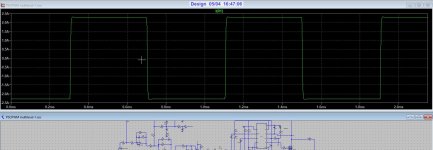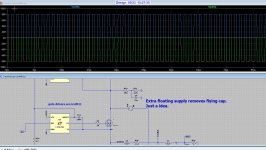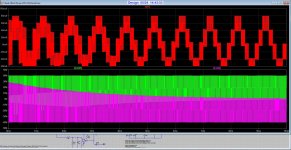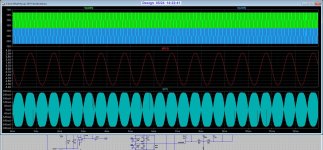No problem.
Learning through experiments is a way of learning but it consumes a lot of time and whatever forum members say is usually aimed at saving your valuable time / spirits.
Learning through experiments is a way of learning but it consumes a lot of time and whatever forum members say is usually aimed at saving your valuable time / spirits.
Here some tests from ltspice.
the feedback is a challence because the fase need to stay around 90 degree, the whole way up.
This I do from yesterday. Nice step test so low pass is nice correced. (postfeedback included).
also open output is stable, and clip.
Mayve I call it the LTspice class D.
the feedback is a challence because the fase need to stay around 90 degree, the whole way up.
This I do from yesterday. Nice step test so low pass is nice correced. (postfeedback included).
also open output is stable, and clip.
Mayve I call it the LTspice class D.
Attachments
Hi newvirus.
I have did a test with one extra supply, removing the capacitor, that works also
when that supply is floating, no more trouble with balancing I gess.
Do not take to serious, it just came op in me think about cascaded versions who need complete floating.
Maybe I have invented a new way. ;-)
I have did a test with one extra supply, removing the capacitor, that works also
when that supply is floating, no more trouble with balancing I gess.
Do not take to serious, it just came op in me think about cascaded versions who need complete floating.
Maybe I have invented a new way. ;-)
Attachments
Well, you're delusional.Maybe I have invented a new way
In universities, the basic working of the flycap inverter working is first established using a battery. The balancing-realed aspects are then introduced by replacing it with a capacitor.
No, not delusional but kind of interests what it does when I use that delusional way of look at it.
I have not a batterie, the multilevels are also used in cars, or the new audio devices for extend
batterie, I do now a extra flying voltage is not usable there, but oke, I just experiment with
this stuff, and go build again when I am ready here around mine house, wintertime
is a nice time for this, but the rain, every day here already for months is a reason.
I have set back the capacitor and have insert a notch lc, when the triangle frequency is
stronger because of disbalans of the cap, it draw current, and as a result the capacitor go in
balance of his own, and stays there, when the balance is reached the current in the notch get low
into the milliamps. It is a way I have read some time ago and never did test, withing a small
timelaps I get 1.2 amps when switch on, and withing 15 ms the cap is balanced.
You do now, new things keeps live interesting?
But that terrible LTspice, crash so now and then, making that I have to do start again from scratch, that is
now the 4th time this happens. it crash when I start simulating,
regards
I have not a batterie, the multilevels are also used in cars, or the new audio devices for extend
batterie, I do now a extra flying voltage is not usable there, but oke, I just experiment with
this stuff, and go build again when I am ready here around mine house, wintertime
is a nice time for this, but the rain, every day here already for months is a reason.
I have set back the capacitor and have insert a notch lc, when the triangle frequency is
stronger because of disbalans of the cap, it draw current, and as a result the capacitor go in
balance of his own, and stays there, when the balance is reached the current in the notch get low
into the milliamps. It is a way I have read some time ago and never did test, withing a small
timelaps I get 1.2 amps when switch on, and withing 15 ms the cap is balanced.
You do now, new things keeps live interesting?
But that terrible LTspice, crash so now and then, making that I have to do start again from scratch, that is
now the 4th time this happens. it crash when I start simulating,
regards
Here a test with cap and a notch, it does very will keeping cap balanced.
The other ways are as you said, need extensive circuits or is included in a controller
with software as most has, most grid invertors for sunpanels. The need is high because of
the high voltages involved, audio has much lower voltages.
design 189 is sim started with zero voltages, and 186 and 188 is when simulation reach stability after 10 mseconds,
I can lower the notch current a lot, if I use settle time of 100ms. resistor in notch needs higher in that case
lowering inrush (charging cap) current. charging current on lower plot 186. distortion on 183 single ended 3 level
flying cap.
Flying capacitor needs much less inductors, and lower voltage mosfets then the other one here mentioned,
but both do well. The feedback setup I am oke with, I go build tests if simulations is what I want to see.
drawn two boards one feedback board and the power board, so I can experiment.
You now the protection circuits are there not yet, this is not needed to simulate, the mosfet drivers have inputs for this
already, just a current measure in mosfet supply lines and dc on output for speaker protection.
regards
The other ways are as you said, need extensive circuits or is included in a controller
with software as most has, most grid invertors for sunpanels. The need is high because of
the high voltages involved, audio has much lower voltages.
design 189 is sim started with zero voltages, and 186 and 188 is when simulation reach stability after 10 mseconds,
I can lower the notch current a lot, if I use settle time of 100ms. resistor in notch needs higher in that case
lowering inrush (charging cap) current. charging current on lower plot 186. distortion on 183 single ended 3 level
flying cap.
Flying capacitor needs much less inductors, and lower voltage mosfets then the other one here mentioned,
but both do well. The feedback setup I am oke with, I go build tests if simulations is what I want to see.
drawn two boards one feedback board and the power board, so I can experiment.
You now the protection circuits are there not yet, this is not needed to simulate, the mosfet drivers have inputs for this
already, just a current measure in mosfet supply lines and dc on output for speaker protection.
regards
Attachments
Last edited:
- Home
- Amplifiers
- Power Supplies
- dead time question
